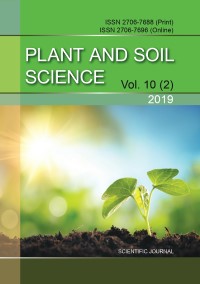The economic efficiency of the fertilizers application under agricultural crops for different soil tillage
DOI:
https://doi.org/10.31548/agr2019.02.062Keywords:
ammonium nitrate (Nаа), urea-ammonium nitrate solution (UAN), soil tillage, agricultural cropsAbstract
In the Ukrainian economic conditions there is a competition between producers of the crops products and it caused their competitiveness in national and international markets. This causes increasing of the farm efficiency. One of the ways for increasing of the farm efficiency is minimization of the soil tillage and rational use of fertilizers. So, the rational fertilizers application for different soil tillage was researched. There were ploughing and mini-till and no-till and split formation. The effect of the ammonium nitrate application and UAN solution on background of the phosphate-potassium fertilizers were researched for these types of soil tillage. These factors were researched for next crops: corn, soybean and spring wheat. For corn the rate of mineral fertilizers was N140P100K100, for soybean it was N60P60K60, for spring wheat it was N100P80K80. Results indicate that the optimal soil tillage for all crops was split formation. And better nitrogen fertilizers were urea-ammonium nitrate solution for two crops (soybean, spring wheat) because in these variants was maximal profitability in these crop production system. It was 95.0 % for soybean and 58.1 % for spring wheat. For corn the best fertilizers were ammonium nitrate where was maximal profitability (54.7 %).References
Datsko, L. (2009). Degradaciya gruntiv - problema siogodennya. [Soil degradation - the problem todays]. Okhorona rodiuchosti gruntiv, 5, 75-78.
Shykula, M. K., Ridei, N. M., Maistrenko, V. H., Hlushchenko, O. Ye. (2003). Pokrashchennia ahrofizychnykh vlastyvostei hruntiv zastosuvanniam tekhnolohii biolohichnoho zemlerobstva. Biolohichni nauky I problem roslynnytstva. [The optimization of the agrophysical soil properties by biological farming. Biological sciences and plant growimg problems]. Zbirnyk naukovykh prats Umanskoho derzhavnoho ahrarnoho universytetu. 777-784.
Filipovic, D., Husnjak, S., Kosutic, S Gospodaric, Z. (2006). Effects of tillage systems on compaction and crop yield of AlbicLuvisol in Croatia. Journal of Terramechanics, 43 (2), 177-189.
https://doi.org/10.1016/j.jterra.2005.04.002
Bondarenko, M. P., Sobko, M. H., Zubenok, O.V., etc. (2010). Zastosuvannia sposobiv osnovnoho obrobitku gruntu v sivozminakh [The using of the types for basic soil tillage in crop rotatios]. SAD, Ukraine, 24.
Derpsh, R. (2008). No-till dlia fermera (yz opыta, nakoplennoho v Latynskoi Ameryke) [No-till for fermers (the practice geting in Letin America]. Zerno, 6, 20-27.
?apre N., Pirnea I., Marin E.[et al.]. (2011). New results for maize crops cultivated in the no-tillagge system at the national institute for agricultural mechanization from Baneasa-Bucharest. Lucraristiintifice, 54, 211 - 218.
Balaiev, A. D. (2010). Humusovanist gruntiv Pravoberezhnoho Lisostepu Ukrainy za riznykh umov yikh vykorystannia. [Humus reserve of the soils in Right-Bank Forest-Steppe of Ukraine for different conditions its' using]. Naukovyi visnyk Natsionalnoho universytetu bioresursiv I aryrodokorystuvannia Ukrainy («Ahronomiia»), 149, 357-362.
Lunkina, T. I. (2010). Efektyvnist intensyfkatsii vyrobnytstva silskohospodarskoi produktsi na osnovi no-till tekhnolohii. [The effect of the intensification for agricultural production based on no-till]. Visnyk ahrarnoi nauky Prychornomoria, 3, 118-123.
Downloads
Published
Issue
Section
License
Relationship between right holders and users shall be governed by the terms of the license Creative Commons Attribution – non-commercial – Distribution On Same Conditions 4.0 international (CC BY-NC-SA 4.0):https://creativecommons.org/licenses/by-nc-sa/4.0/deed.uk
Authors who publish with this journal agree to the following terms:
- Authors retain copyright and grant the journal right of first publication with the work simultaneously licensed under a Creative Commons Attribution License that allows others to share the work with an acknowledgement of the work's authorship and initial publication in this journal.
- Authors are able to enter into separate, additional contractual arrangements for the non-exclusive distribution of the journal's published version of the work (e.g., post it to an institutional repository or publish it in a book), with an acknowledgement of its initial publication in this journal.
- Authors are permitted and encouraged to post their work online (e.g., in institutional repositories or on their website) prior to and during the submission process, as it can lead to productive exchanges, as well as earlier and greater citation of published work (See The Effect of Open Access).

